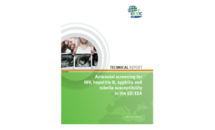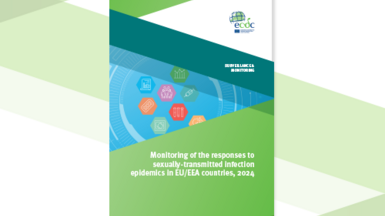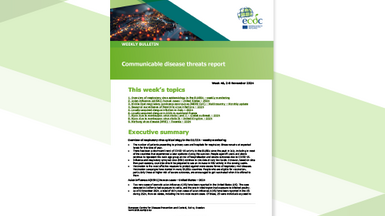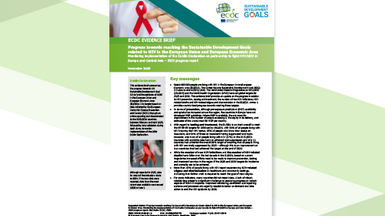Antenatal screening for HIV, hepatitis B, syphilis and rubella susceptibility in the EU/EEA
The results of this survey among national public health experts indicate that limited access to antenatal care services, combined with low testing uptake among pregnant women in certain subpopulations, often leads to low screening coverage for HIV, hepatitis B, syphilis and rubella susceptibility, especially in vulnerable groups.
Executive Summary
Annually, more than 5 million live births are recorded in the EU. Antenatal screening for HIV, hepatitis B, syphilis and rubella susceptibility is widely implemented in the EU/EEA, most commonly with opt-out testing policies followed by universal screening during pregnancy. But despite availability of effective preventive interventions, transmission of infections with HIV, hepatitis B, syphilis or rubella from mother to child before and during birth as well as in infancy still occur across Europe.In the vast majority of EU/EEA countries (96%), the provision of antenatal care to pregnant women is based on national guidance, screening recommendations or a prevention strategy. In 2011, the global community defined the elimination of mother-to-child transmission (MTCT) of HIV and syphilis as a public health priority. Responses from 26 EU/EEA countries that answered to an ECDC survey in 2013 showed that they had either reached, or were very close to reaching, the targets for the elimination of MTCT of HIV and syphilis. However, mother-to-child transmission is still reported in several European countries. In addition, few countries collect the data needed to document performance of antenatal screening programmes.
The survey results, published in a new ECDC report, indicate that reasons for on-going MTCT of these infections in Europe could be that effective antenatal screening strategies are compromised by incomplete screening coverage, poor access to antenatal care, or inadequate HIV, syphilis and hepatitis testing among women among groups at high risk. These groups include migrants from high prevalence countries, women exercising high risk behaviours (e.g. women who inject drugs), women who are tested late in the course of their pregnancy or those without access to antenatal care.
In reaction to these findings, ECDC is currently developing evidence-based guidance to help Member States strengthen antenatal screening among vulnerable groups. The guidance will look at which elements of a national antenatal screening programme for infections influence effectiveness, and which are the specific approaches to be used for reaching the vulnerable groups in order to increase the uptake of prenatal care and reduce/prevent MTCT.
Why test for infections during pregnancy
Mother-to-child transmission is the most predominant mode of HIV infection in children worldwide. Without intervention, the risk of HIV transmission from an infected mother to her child ranges from 15% to 30% during pregnancy/delivery to between 10% and 20% during breastfeeding. This risk can be reduced to 1 to 2% with a combination of appropriate antenatal interventions including anti-retroviral therapy (ART) for the mother, anti-retroviral prophylaxis for the newborn, and avoidance of breastfeeding.
Transmission of hepatitis B from mother to child is preventable in 95% of all cases through the administration of vaccine and immunoglobulin to the baby at birth. With no immunoprophylaxis, more than 90% of infants infected by their positive mothers will go on to develop chronic infection.
There is no treatment for rubella but MTCT can be prevented by ensuring that all women who plan to get pregnant are immune or have been immunised against rubella.








